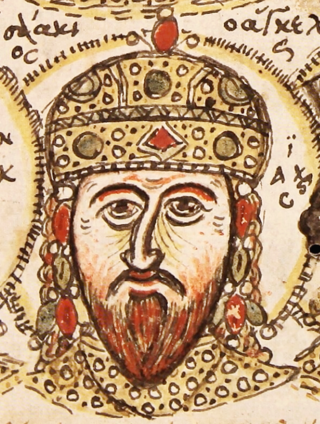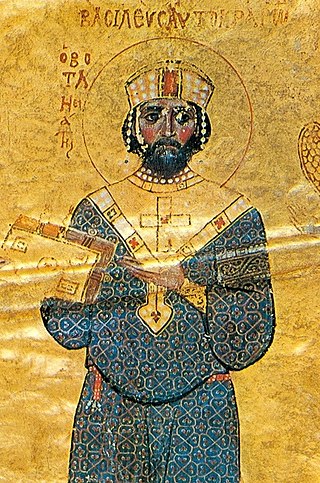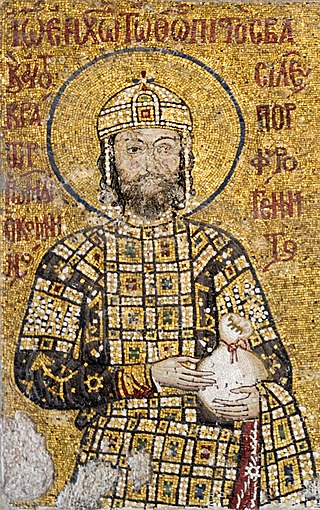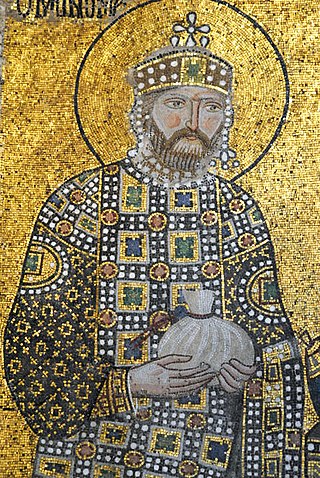
Alexios I Komnenos, Latinized Alexius I Comnenus, was Byzantine emperor from 1081 to 1118. Although he was not the first emperor of the Komnenian dynasty, it was during his reign that the Komnenos family came to full power and initiated a hereditary succession to the throne. Inheriting a collapsing empire and faced with constant warfare during his reign against both the Seljuq Turks in Asia Minor and the Normans in the western Balkans, Alexios was able to curb the Byzantine decline and begin the military, financial, and territorial recovery known as the Komnenian restoration. His appeals to Western Europe for help against the Turks was the catalyst that sparked the First Crusade.

Alexios III Angelos, Latinized as Alexius III Angelus, was Byzantine Emperor from March 1195 to 17/18 July 1203. He reigned under the name Alexios Komnenos associating himself with the Komnenos dynasty.

Andronikos I Komnenos, Latinized as Andronicus I Comnenus, was Byzantine emperor from 1183 to 1185. He was the son of Isaac Komnenos and the grandson of the emperor Alexios I. In later Byzantine historiography, Andronikos I became known under the epithet "Misophaes" in reference to the great number of enemies he had blinded.

Isaac II Angelos or Angelus was Byzantine Emperor from 1185 to 1195, and co-Emperor with his son Alexios IV Angelos from 1203 to 1204. In a 1185 revolt against the Emperor Andronikos Komnenos, Isaac seized power and rose to the Byzantine throne, establishing the Angelos family as the new imperial dynasty.

Nikephoros III Botaneiates, Latinized as Nicephorus III Botaniates, was Byzantine Emperor from 7 January 1078 to 1 April 1081. He was born in 1002, and became a general during the reign of Byzantine Emperor Constantine IX Monomachos, serving in the Pecheneg revolt of 1048–1053. His actions in guiding his forces away from the Pechenegs following the Battle of Zygos Pass, in which they suffered eleven days of harassment before finally reaching the Byzantine city of Adrianople, attracted the attention of fellow officers, and he received the title of magistros as a reward. Nikephoros served in the revolt of Isaac I Komnenos against the Byzantine Emperor Michael VI Bringas, leading forces at the decisive Battle of Petroe. Under the Emperor Constantine X Doukas he was made doux of Thessalonica. He later served as doux of Antioch. While doux of Antioch, he repelled numerous incursions from the Emirate of Aleppo. When Constantine X died in 1067, his wife, Empress Eudokia Makrembolitissa, considered taking Nikephoros as husband and emperor but instead chose Romanos IV Diogenes. The need for an immediate successor was made pressing by the constant Seljuk raids into Byzantine Anatolia, and Eudokia, Patriarch John VIII of Constantinople, and the Byzantine Senate agreed that their top priority was the defense of the empire and that they needed an emperor to lead troops to repel the Turks. Nikephoros was the favorite candidate of the senate, but was in the field leading troops in Antioch and was still married. Romanos, once chosen to be emperor, exiled Nikephoros to his holdings in the Anatolic Theme, where he remained until he was brought out of retirement by the Emperor Michael VII and made kouropalates and governor of the Anatolic Theme.

John II Komnenos or Comnenus was Byzantine emperor from 1118 to 1143. Also known as "John the Beautiful" or "John the Good", he was the eldest son of Emperor Alexios I Komnenos and Irene Doukaina and the second emperor to rule during the Komnenian restoration of the Byzantine Empire. As he was born to a reigning emperor, he had the status of a porphyrogennetos. John was a pious and dedicated monarch who was determined to undo the damage his empire had suffered following the Battle of Manzikert, half a century earlier.

Michael V Kalaphates was Byzantine emperor for four months in 1041–1042. He was the nephew and successor of Michael IV and the adoptive son of Michael IV's wife Empress Zoe. He was popularly called "the Caulker" (Kalaphates) in accordance with his father's original occupation.

The Battle of Manzikert or Malazgirt was fought between the Byzantine Empire and the Seljuk Empire on 26 August 1071 near Manzikert, theme of Iberia. The decisive defeat of the Byzantine army and the capture of the Emperor Romanos IV Diogenes played an important role in undermining Byzantine authority in Anatolia and Armenia, and allowed for the gradual Turkification of Anatolia. Many Turks, travelling westward during the 11th century, saw the victory at Manzikert as an entrance to Asia Minor.

Constantine IX Monomachos reigned as Byzantine emperor from June 1042 to January 1055. Empress Zoë Porphyrogenita chose him as a husband and co-emperor in 1042, although he had been exiled for conspiring against her previous husband, Emperor Michael IV the Paphlagonian. The couple shared the throne with Zoë's sister Theodora Porphyrogenita. Zoë died in 1050, and Constantine continued his collaboration with Theodora until his own death five years later.

The Battle of Arcadiopolis was fought in 970 between a Byzantine army under Bardas Skleros and a Rus' army, the latter also including allied Bulgarian, Pecheneg, and Hungarian (Magyar) contingents. In the preceding years, the Rus' ruler Sviatoslav had conquered northern Bulgaria, and was now menacing Byzantium as well. The Rus' force had been advancing through Thrace towards Constantinople when it was met by Skleros' force. Having fewer men than the Rus', Skleros prepared an ambush and attacked the Rus' army with a portion of his force. The Byzantines then feigned retreat, and succeeded in drawing off the Pecheneg contingent into the ambush, routing it. The remainder of the Rus' army then suffered heavy casualties from the pursuing Byzantines. The battle was important as it bought time for the Byzantine emperor John I Tzimiskes to settle his internal problems and assemble a large expedition, which eventually defeated Sviatoslav the next year.

The Byzantine–Seljuk wars were a series of conflicts in the Middle Ages between the Byzantine Empire and the Seljuk Empire. They shifted the balance of power in Asia Minor and Syria from the Byzantines to the Seljuk dynasty. Riding from the steppes of Central Asia, the Seljuks replicated tactics practiced by the Huns hundreds of years earlier against a similar Roman opponent but now combining it with new-found Islamic zeal. In many ways, the Seljuk resumed the conquests of the Muslims in the Byzantine–Arab Wars initiated by the Rashidun, Umayyad and Abbasid Caliphates in the Levant, North Africa and Asia Minor.
Leo Phokas was an early 10th-century Byzantine general of the noble Phokas clan. As Domestic of the Schools, the Byzantine army's commander-in-chief, he led a large-scale campaign against the Bulgarians in 917, but was heavily defeated at the battles of Acheloos and Katasyrtai. He then plotted to seize the throne from the young Byzantine emperor Constantine VII, but was outmaneuvered by the admiral Romanos Lekapenos, who managed to become guardian and later father-in-law of the Emperor. After Lekapenos seized control of the Byzantine Empire, Leo led an unsuccessful revolt, and was captured and blinded.

The Byzantine Empire was ruled by emperors of the Komnenos dynasty for a period of 104 years, from 1081 to about 1185. The Komnenian period comprises the reigns of five emperors, Alexios I, John II, Manuel I, Alexios II and Andronikos I. It was a period of sustained, though ultimately incomplete, restoration of the military, territorial, economic and political position of the Byzantine Empire.

Between 780–1180, the Byzantine Empire and the Abbasid & Fatimid caliphates in the regions of Iraq, Palestine, Syria, Anatolia and Southern Italy fought a series of wars for supremacy in the Eastern Mediterranean. After a period of indecisive and slow border warfare, a string of almost unbroken Byzantine victories in the late 10th and early 11th centuries allowed three Byzantine Emperors, namely Nikephoros II Phokas, John I Tzimiskes and finally Basil II to recapture territory lost to the Muslim conquests in the 7th century Arab–Byzantine wars under the failing Heraclian Dynasty.
The Battle of Kapetron or Kapetrou was fought between a Byzantine-Georgian army and the Seljuq Turks at the plain of Kapetron in 1048. The event was the culmination of a major raid led by the Seljuq prince Ibrahim Inal into Byzantine-ruled Armenia. A combination of factors meant that the regular Byzantine forces were at a considerable numerical disadvantage against the Turks: the local thematic armies had been disbanded, while many of the professional troops had been diverted to the Balkans to face the revolt of Leo Tornikios. As a result, the Byzantine commanders, Aaron and Katakalon Kekaumenos, disagreed on how best to confront the invasion. Kekaumenos favoured an immediate and pre-emptive strike, while Aaron favoured a more cautious strategy until the arrival of reinforcements. Emperor Constantine IX chose the latter option and ordered his forces to adopt a passive stance, while requesting aid from the ruler of Georgian Duchy of Kldekari, Liparit IV. This allowed the Turks to ravage at will, notably leading to the sack and destruction of the great commercial centre of Artze.

This history of the Byzantine Empire covers the history of the Eastern Roman Empire from late antiquity until the Fall of Constantinople in 1453 AD. Several events from the 4th to 6th centuries mark the transitional period during which the Roman Empire's east and west divided. In 285, the emperor Diocletian partitioned the Roman Empire's administration into eastern and western halves. Between 324 and 330, Constantine I transferred the main capital from Rome to Byzantium, later known as Constantinople and Nova Roma. Under Theodosius I, Christianity became the Empire's official state religion and others such as Roman polytheism were proscribed. Finally, under the reign of Heraclius, the Empire's military and administration were restructured and adopted Greek for official use instead of Latin. Although the Roman state continued, some historians choose to distinguish the Byzantine Empire from the earlier Roman Empire due to the imperial seat moving from Rome to Byzantium, the Empire’s integration of Christianity, and the predominance of Greek instead of Latin.

Konstantios Doukas, Latinized as Constantius Ducas, was a junior Byzantine emperor from 1060 to 1078. Konstantios was the son of Emperor Constantine X Doukas and Empress Eudokia Makrembolitissa. Upon his birth, he was elevated to junior emperor, along with his brother Michael VII. He remained as junior emperor during the reigns of Constantine, Romanos IV, and Michael VII. He was handed over to Nikephoros III, a usurper, following the abdication of Michael VII. He was sent to live in a monastery, where he stayed until recalled by Alexios I Komnenos, who made him a general. He was killed in 1081, in the Battle of Dyrrhachium. Sources sometimes confuse him with his nephew, Constantine Doukas.

Sviatoslav's invasion of Bulgaria refers to a conflict beginning in 967/968 and ending in 971, carried out in the eastern Balkans, and involving the Kievan Rus', Bulgaria, and the Byzantine Empire. The Byzantines encouraged the Rus' ruler Sviatoslav to attack Bulgaria, leading to the defeat of the Bulgarian forces and the occupation of the northern and north-eastern part of the country by the Rus' for the following two years. The allies then turned against each other, and the ensuing military confrontation ended with a Byzantine victory. The Rus' withdrew and eastern Bulgaria was incorporated into the Byzantine Empire.
The Pecheneg revolt was an uprising of the Pechenegs against the Byzantine Empire, which lasted from 1049 to 1053.
Tyrach, Pecheneg chieftain in 1048, also known as Tirakh or Tirek, whose quarrel with his military commander Ioannes Kegen led to the Pecheneg revolt of 1048–1053. Kegen and his followers relocated to Paristrion. With the blessing of emperor Constantine IX Manomachos, Kegen was to protect a sector of the empire from invasion, but continued to harass Tyrach. Tyrach responded by a massive invasion of Byzantium, but, once defeated, was allowed keep his army to aid in defending the empire against Seljuk incursions. Tyrach instead turned to rebellion and was arrested. Kegen was sent to replace him, but upon rumors of insurrection, he was also arrested. The emperor again turned to Tyrach to lead the Pecheneg, but instead rebelled and was defeated at a decisive battle at Adrianople in 1050 where he presumably died.
















